There is an amazing variety of options that exist in the world of indoor plants, each with its own distinct appeal and personality. Sansevieria cylindrica, the cylindrical snake plant, is notable for both its amazing stubbornness and architectural shape among these species. This succulent, sometimes called the African spear plant has a striking appearance. Its upright, cylindrical leaves rise out of the pot like tiny green spears.
The cylindrical snake plant is visually appealing, but what really draws people in is how easy it is to care for. It’s a great option for busy plant lovers or those who are new to indoor gardening because it thrives in neglect rather than overcare. However, the cylindrical snake plant’s appeal doesn’t end there. Surprisingly diverse among its members, this intriguing species offers a variety of textures, hues, and growth patterns to accommodate a wide range of aesthetic tastes.
This thorough explores the fascinating world of snake plant species that are cylindrical in shape. We’ll go over the particular maintenance needs for each kind so you may have the knowledge you need to take care of these African spear plant in your own house. We’ll highlight the distinctive qualities of each variety, from the stately ‘Skyline’ with its thick, erect leaves to the intriguing ‘Microscopa’ with its hair-like foliage. This guide will help you find the ideal cylindrical snake plant to enhance your indoor refuge, whether you’re looking for a low-maintenance accent for a darkly lit space or a statement piece for a brightly illuminated corner.
Cylindrical Snake Plant Varieties
- Sansevieria cylindrica ‘Skyline’
- Sansevieria cylindrica ‘Starfish’ (Sansevieria cylindrica var. Patula)
- Sansevieria cylindrica ‘Spaghetti’
- Sansevieria cylindrica ‘Cleopatra’
- Sansevieria cylindrica ‘Craigii’
- Sansevieria cylindrica ‘Microscopa’
- Sansevieria cylindrica ‘Confederate Flag’
- Sansevieria cylindrica ‘Boncel’
- Sansevieria cylindrica ‘Sunrise’
How to care for cylindrical snake plant
1-‘Skyline’ Sansevieria cylindrical
The ‘Skyline’ kind perfectly captures the essence of the classic cylindrical snake plant. It is well known for its sturdy form and has the thickest, straightest leaves of all its relatives. Reaching up to three feet in height, these emerald green spears create a striking vertical accent. The concave channel that runs down the middle of each leaf is a fascinating detail that adds a fascinating textural element. Low-maintenance champion ‘Skyline’ grows best in bright, indirect sunlight and needs little to no irrigation.
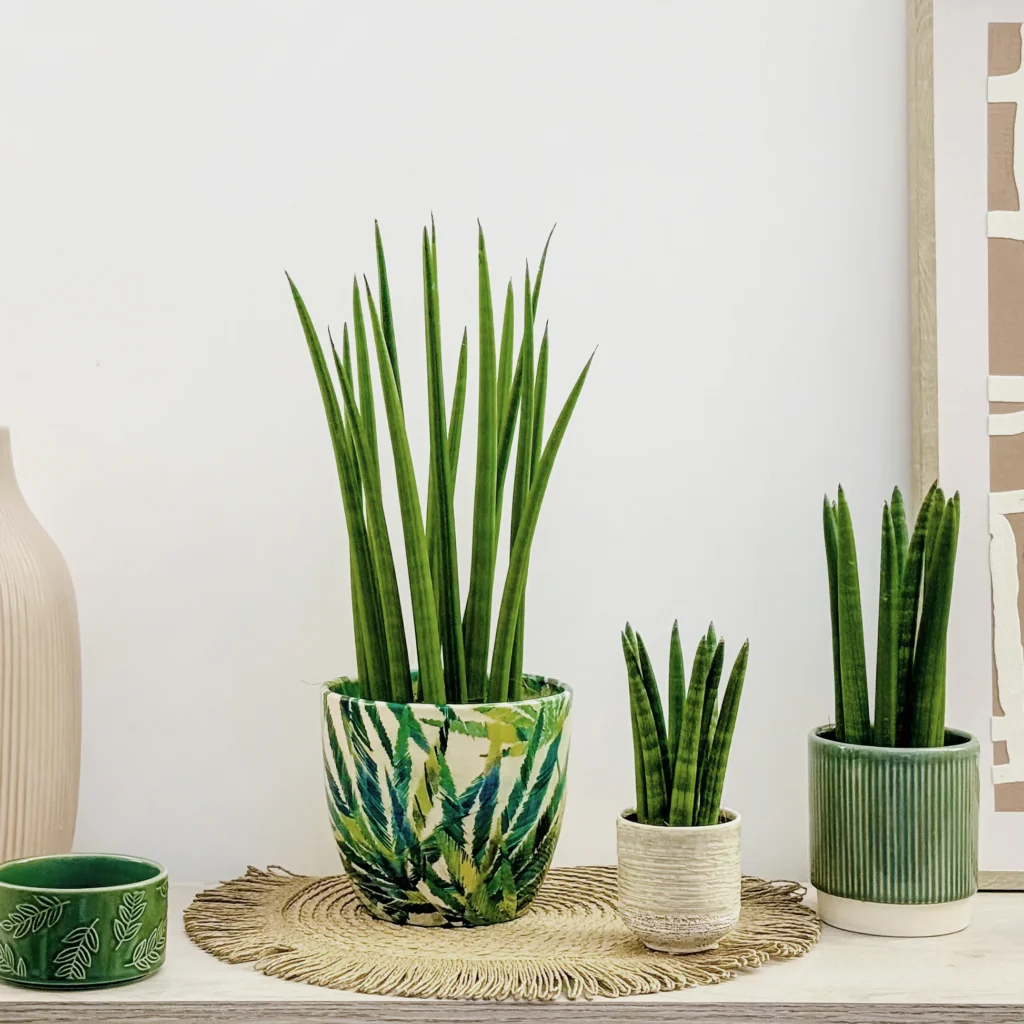
Maintenance: This type needs well-draining potting soil to flourish. In the spring and summer, water sparingly, letting the soil dry out completely in between applications. In the winter, drastically cut back on watering. For best growth, provide bright, indirect sunshine. To guarantee even growth, rotate the plant from time to time.
Pruning: Unless a leaf gets damaged or overgrown, Skyline usually doesn’t need to be pruned. To get rid of undesirable growth, use sterile, sharp scissors.
Propagation: Use leaf cuttings to spread this cultivar. Before planting a severed leaf part in a well-draining medium, let it calluses for a few days.
Watering: As previously indicated, give the soil a moderate amount of water in the spring and summer, letting it dry fully in between applications. In order to avoid root rot in the winter, drastically reduce watering.
Sun Requirements: Optimal sunlight is bright, indirect. Steer clear of intense, direct sunlight since it may burn the leaves.
Warm temperatures between 65°F (18°C) to 80°F (27°C) are preferred. Keep it out of the cold and the frost.
Humidity: Acclimates well to typical humidity levels found in homes.
Fertilizer Requirements: During the growing season (spring and summer), apply a balanced, diluted liquid fertilizer once a month. Don’t use fertilizer in the fall or winter.
2-‘Starfish’ Sansevieria cylindrica (Sansevieria cylindrica var. Patula)
Take a whimsy turn with the ‘Starfish’ variation. This unusual cultivar defies expectations with its outward-growing leaves that gently bend downward, in contrast to its upright siblings. This gives your interior décor a whimsical touch while producing an eye-catching silhouette resembling a starfish. The ‘Starfish’s’ triangular leaf cross-section adds even more visual interest to the plant. It grows best in environments similar to “Skyline,” with bright, indirect light and minimal irrigation being its preferences.
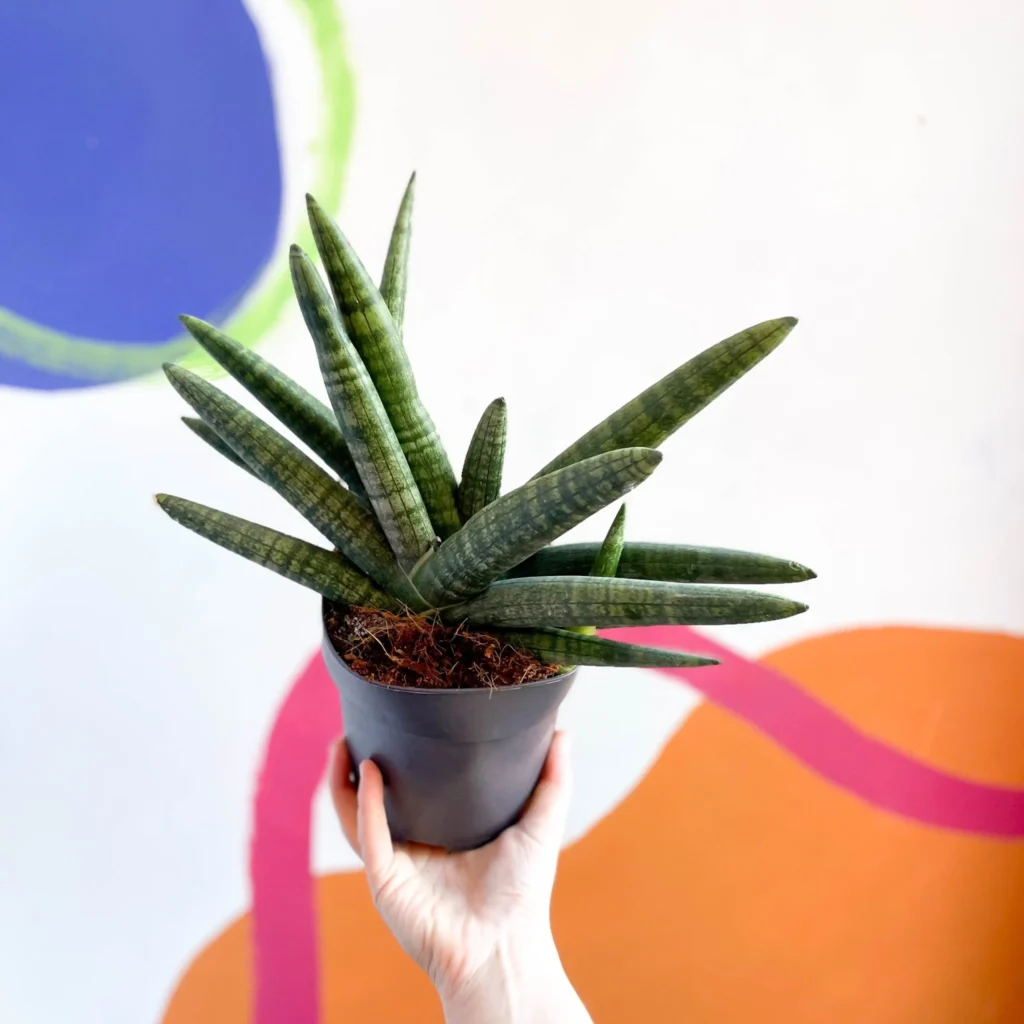
Maintenance: Like Skyline, Starfish needs well-draining soil and light summertime irrigation. For even growth, expose the plant to bright, indirect sunlight and turn it around every so often.
Pruning: Remove broken or excessive leaves using sterile shears only when necessary.
Propagation: Use the same technique as Skyline to spread by leaf cuttings.
Watering: In the spring and summer, provide a moderate amount of water, letting the soil dry fully in between applications. In the winter, drastically cut back on watering.
Sun Requirements: Prefers indirect, bright sunshine. Steer clear of bright, direct sunlight.
Temperature: This plant grows best in warm climates of 65°F (18°C) to 80°F (27°C). Keep out of the cold drafts and the frost.
Humidity: Acclimates well to typical humidity levels found in homes.
Fertilizer Requirements: During the growing season, apply a balanced, diluted liquid fertilizer once a month. Don’t use fertilizer in the fall or winter.
3-‘Spaghetti’, or Sansevieria cylindrical
The ‘Spaghetti’ version is a cute substitute for people who like a more delicate look. As implied by the name, this variety of cylindrical snake plant has the thinnest leaves. These pliable, light green leaves have a gentle, flowing appearance that makes them perfect for smoothing edges or providing a little of textural contrast. ‘Spaghetti’ seems fragile, yet it’s as hardy as its siblings with thicker leaves. Like other cylindrica cultivars, it grows best in bright, indirect sunshine and needs regular watering.
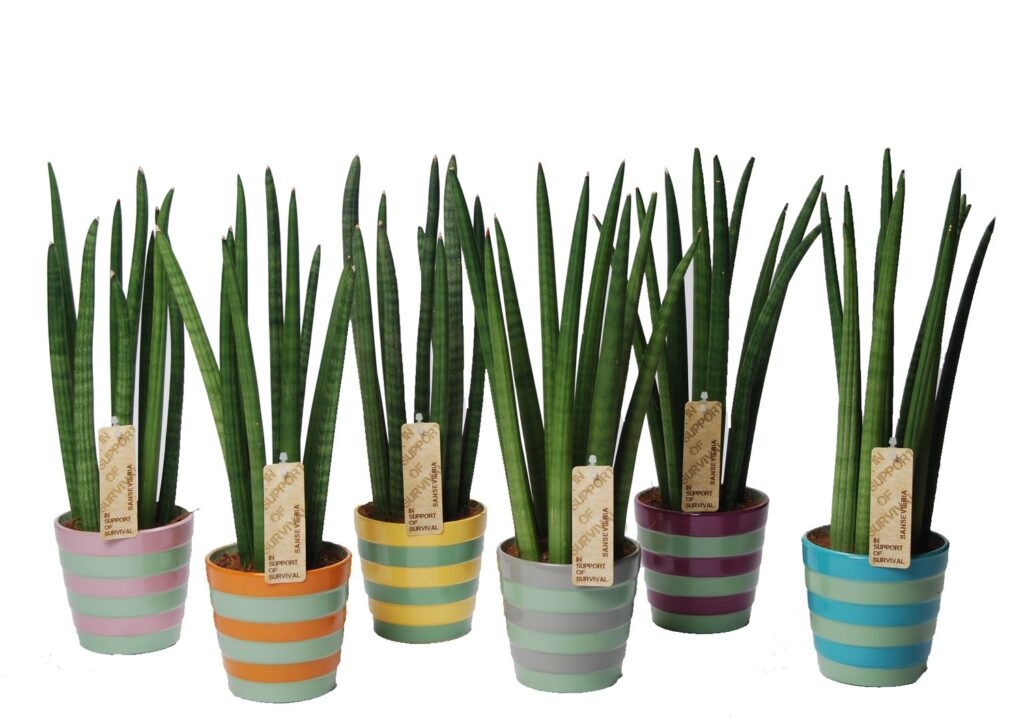
Maintenance: This kind needs soil that drains well and light spring and summer irrigation. It may dry out significantly earlier than other cylindrica cultivars because of its thinner leaves. Let there be plenty of indirect, bright sunshine.
Pruning: Remove broken or excessive leaves using sterile shears only when necessary.
Propagation: Use the same technique as Skyline to spread by leaf cuttings.
Watering: In the spring and summer, provide a moderate amount of water, letting the soil dry fully in between applications. Because the leaves are thinner than in other kinds, you will need to check the soil moisture content more often. In the winter, drastically cut back on watering.
Sun Requirements: Prefers indirect, bright sunshine. Steer clear of bright, direct sunlight.
Temperature: This plant grows best in warm climates of 65°F (18°C) to 80°F (27°C). Keep out of the cold drafts and the frost.
Humidity: Acclimates well to typical humidity levels found in homes.
Fertilizer Requirements: During the growing season, apply a balanced, diluted liquid fertilizer once a month. Don’t use fertilizer in the fall or winter.
4-Sansevieria cylindrica ‘Cleopatra’
Take on a refined appearance by wearing the ‘Cleopatra’ variation. This cultivar is distinguished by its thin, curving leaves, which give your indoor environment a hint of movement and beauty. The glossy shine of the dark green leaves adds to their elegant appeal. Similar to other cylindrica types, “Cleopatra” grows well in bright, indirect sunlight with moderate watering. Because of its unusual shape, it’s a compelling option for anybody looking to add some drama to their plant collection.
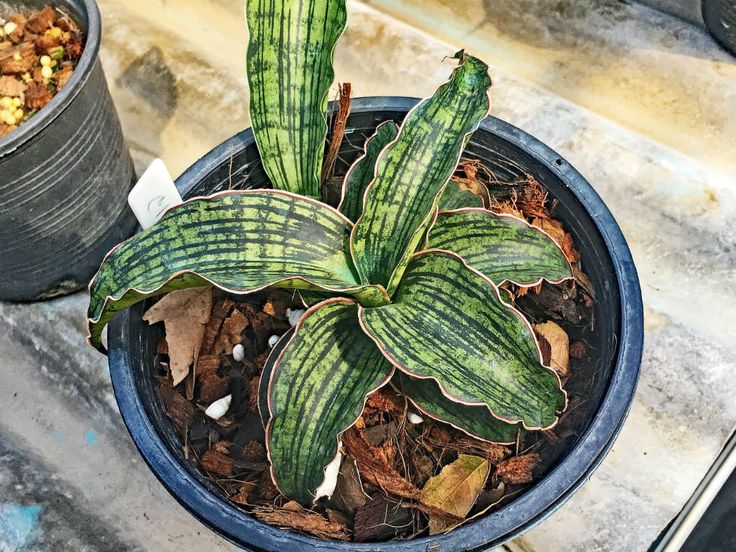
Maintenance: Cleopatra needs well-draining soil and moderate spring and summer watering, same like other cylindrica cultivars. For even growth, expose the plant to bright, indirect sunlight and turn it around every so often.
Pruning: Remove broken or excessive leaves using sterile shears only when necessary.
Propagation: Use the same technique as Skyline to spread by leaf cuttings.
Watering: In the spring and summer, provide a moderate amount of water, letting the soil dry fully in between applications. In the winter, drastically cut back on watering.
Sun Requirements: Prefers indirect, bright sunshine. Steer clear of bright, direct sunlight.
Temperature: This plant grows best in warm climates of 65°F (18°C) to 80°F (27°C). Keep out of the cold drafts and the frost.
Humidity: Acclimates well to typical humidity levels found in homes.
Fertilizer Requirements: During the growing season, apply a balanced, diluted liquid fertilizer once a month. Don’t use fertilizer in the fall or winter.
5-‘Craigii’ Sansevieria cylindrical
The ‘Craigii’ variety is the ideal choice if space is limited. At about 12 inches tall on average, this dwarf cultivar is a cute little version of the cylindrical snake plant. Its tiny, stubby leaves are small in size yet still have the distinctive cylindrical shape. “Craigii” is a great option for terrariums, window sills, and tabletops. Though smaller in stature, it requires less care than its taller siblings; it thrives in bright, indirect light and just has to be watered occasionally.
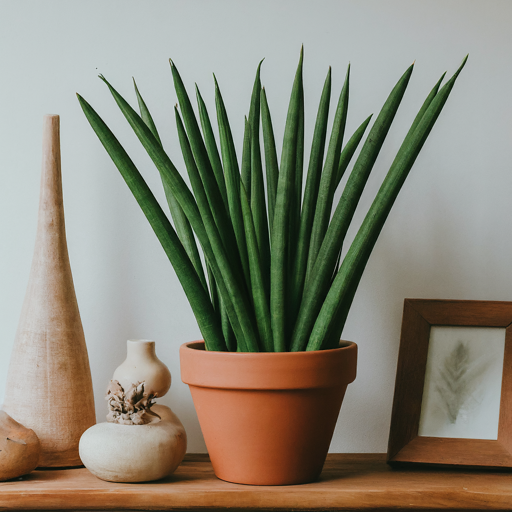
Maintenance: This small kind grows best in soil that drains well and receives moderate spring and summer watering. It may need to be watered a little less regularly than taller cultivars because of its smaller size. Let there be plenty of indirect, bright sunshine.
Pruning: Because Craigii are little plants, pruning is usually not essential. But if necessary, cut away any damaged leaves with sterile shears.
Propagation: Use the same technique as Skyline to spread by leaf cuttings. If the plant has produced pups, or young Sansevieria shoots, at its base, you can also propagate by division.
Watering: In the spring and summer, provide a moderate amount of water, letting the soil dry fully in between applications. Depending on the size of the plant and pot drainage, alter the frequency of watering. In the winter, drastically cut back on watering.
Sun Requirements: Prefers indirect, bright sunshine. Steer clear of bright, direct sunlight.
Temperature: This plant grows best in warm climates of 65°F (18°C) to 80°F (27°C). Keep out of the cold drafts and the frost.
Humidity: Acclimates well to typical humidity levels found in homes.
Fertilizer Requirements: During the growing season, apply a balanced, diluted liquid fertilizer once a month. Don’t use fertilizer in the fall or winter.
6-‘Microscopa’ Sansevieria cylindrical
The ‘Microscopa’ variety beckons to the real plant aficionado looking for a rare jewel. Of all the cylindrica variations, this enigmatic variety has the thinnest leaves—think tiny green hairs. The delicate nature of ‘Microscopa’ necessitates particular caution when it comes to watering; mild, occasional applications are required to avoid overwatering. Compared to other cylindrica cultivars, it grows best in bright, indirect light with slightly higher humidity levels.
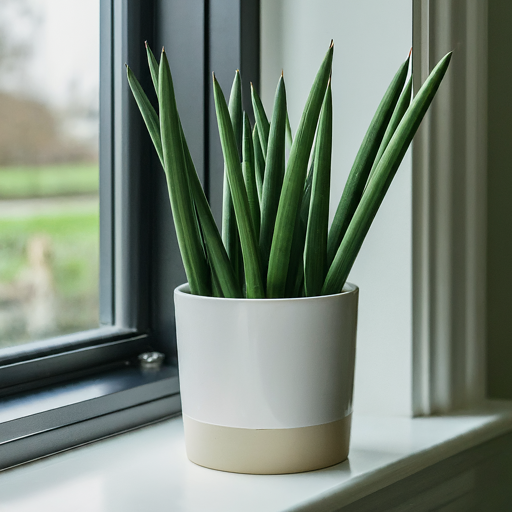
Maintenance: This unusual species needs very careful watering and well-draining soil. It is more prone to overwatering because of its incredibly thin leaves.
Watering: In the spring and summer, water the soil lightly and wait until it has completely dried up before applying more water. Do not overwater your plants. Let there be plenty of indirect, bright sunshine.
Pruning: Microscopa is not likely to require pruning.
Propagation: Because the leaves are thin, it may be difficult to propagate through leaf cuttings. If possible, give the cut leaf piece plenty of time to harden off before replanting. It is not advisable to divide this sensitive variety.
Watering: Give the soil very little water in the spring and summer, letting it dry out completely before adding more. This cultivar is seriously threatened by overwatering. In the winter, cut back on watering even more.
Sun Requirements: Prefers indirect, bright sunshine. Steer clear of bright, direct sunlight.
Temperature: This plant grows best in warm climates of 65°F (18°C) to 80°F (27°C). Keep out of the cold drafts and the frost.
Humidity: Compared to other cylindrica cultivars, Microscopa may benefit from somewhat greater humidity conditions. To improve localized humidity, you can use a pebble tray or spritz the plant once in a while.
Requirements for Fertilizer: Since Microscopa grows slowly, fertilizer is not required. To avoid damaging the roots, completely avoid fertilizing.
7-‘Confederate Flag’ Sansevieria cylindrica type
Accept a little variation by going with the “Confederate Flag” variety. This cultivar has traditional cylindrical leaves with stripes that contrast between green and yellow that run the length of them. The vivid foliage blends well with modern or eclectic décor styles while adding a hint of visual appeal. Like other cylindrica types, “Confederate Flag” grows well in bright, indirect sunshine with moderate watering. Watch out for strong, direct sunlight since it might burn the leaves with variegation.
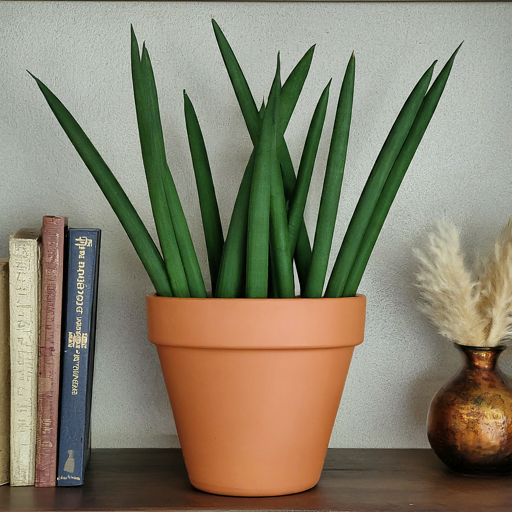
Maintenance: Confederate Flag requires well-draining soil and moderate spring and summer watering, same like other cylindrica cultivars. For even growth, expose the plant to bright, indirect sunlight and turn it around every so often.
Pruning: Remove broken or excessive leaves using sterile shears only when necessary.
Propagation: Use the same technique as Skyline to spread by leaf cuttings. On the other hand, keep in mind that propagated progeny may not accurately mimic variegation, or leaf color patterns.
Watering: In the spring and summer, provide a moderate amount of water, letting the soil dry fully in between applications. In the winter, drastically cut back on watering.
Sun Requirements: Prefers indirect, bright sunshine. Steer clear of intense sunshine as it may burn the leaves with variegation.
Temperature: This plant grows best in warm climates of 65°F (18°C) to 80°F (27°C). Keep out of the cold drafts and the frost.
Humidity: Acclimates well to typical humidity levels found in homes.
Fertilizer Requirements: During the growing season, apply a balanced, diluted liquid fertilizer once a month. Don’t use fertilizer in the fall or winter. Remember that excessive fertilization might have a detrimental effect on variation.
8-‘Boncel’ Sansevieria cylindrical
Like ‘Confederate Flag,’ the ‘Boncel cultivar has an equally impressive variegated foliage show. But instead of stripes, ‘Boncel’ has dark green leaves with a bright yellow ring edging them. This alluring combination stands out in any indoor environment since it makes a powerful visual statement. Similar to “Confederate Flag,” “Boncel” grows well in bright, indirect sunlight with moderate watering. Avoid overfertilizing, just like with other variegated kinds, to avoid affecting the vivid color of the leaves.
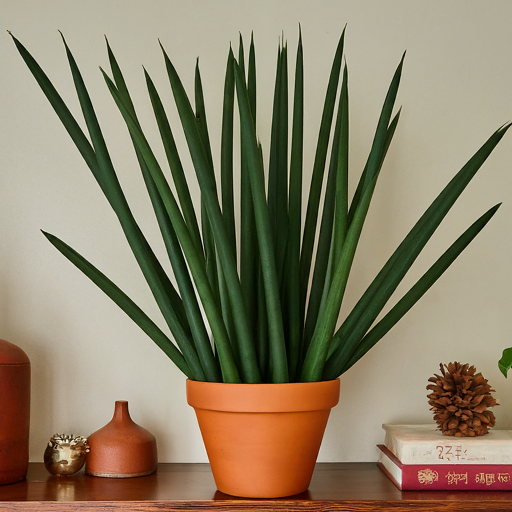
Maintenance: Well-draining soil and moderate spring and summer watering are ideal for the growth of this variegated species. For even growth, expose the plant to bright, indirect sunlight and turn it around every so often.
Pruning: Remove broken or excessive leaves using sterile shears only when necessary.
Propagation: Use the same technique as Skyline to spread by leaf cuttings. Like ‘Confederate Flag,’ variegation in plants that are propagated may not always be exact.
Watering: In the spring and summer, provide a moderate amount of water, letting the soil dry fully in between applications. In the winter, drastically cut back on watering.
Sun Requirements: Prefers indirect, bright sunshine. Steer clear of intense sunshine as it may burn the leaves with variegation.
Temperature: This plant grows best in warm climates of 65°F (18°C) to 80°F (27°C). Keep out of the cold drafts and the frost.
Humidity: Acclimates well to typical humidity levels found in homes.
Fertilizer Requirements: During the growing season, apply a balanced, diluted liquid fertilizer once a month. Don’t use fertilizer in the fall or winter. Applying fertilizer too heavily can have a detrimental effect on variegation, so use caution.
9-‘Sunrise’ Sansevieria cylindrical
Grab a glimpse of sunlight by choosing the ‘Sunrise’ variation. This cultivar is eye-catching; it has green leaves with a bright yellow center that looks like a tiny dawn. This vibrant color scheme enlivens every space and gives a hint of brightness. Similar to other cylindrica cultivars, “Sunrise” is a laid-back plant that thrives in bright, indirect sunshine and needs only minimal watering. Keep in mind that overfertilizing can have a detrimental effect on variegation, so use caution while fertilizing this colorful plant.
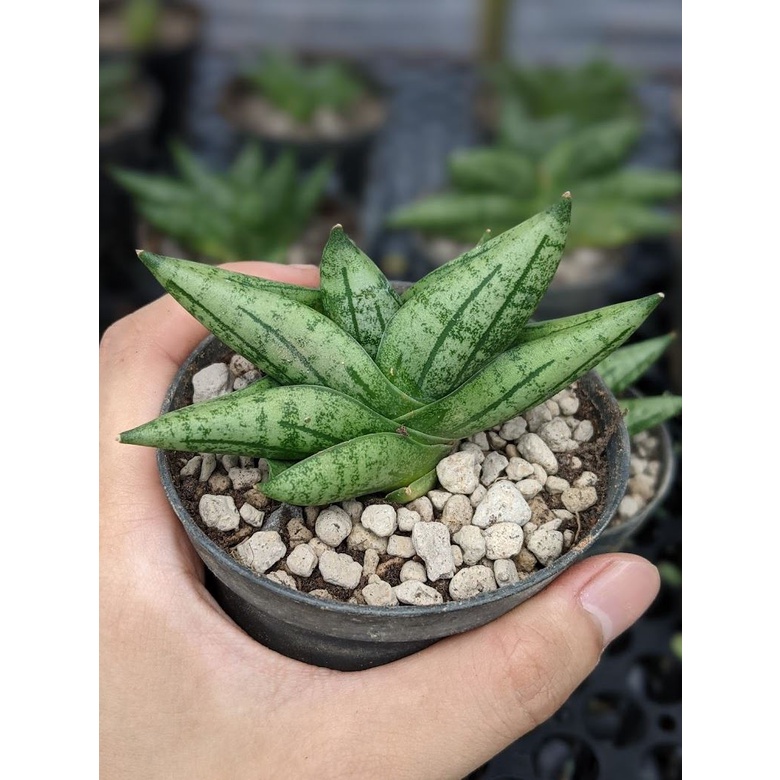
Maintenance: Sunrise requires well-draining soil and moderate spring and summer watering, same like other cylindrica cultivars. For even growth, expose the plant to bright, indirect sunlight and turn it around every so often.
Pruning: Remove broken or excessive leaves using sterile shears only when necessary.
Propagation: Use the same technique as Skyline to spread by leaf cuttings.
Watering: In the spring and summer, provide a moderate amount of water, letting the soil dry fully in between applications. In the winter, drastically cut back on watering.
Sun Requirements: Prefers indirect, bright sunshine. Steer clear of intense sunshine as it may burn the leaves with variegation.
Temperature: This plant grows best in warm climates of 65°F (18°C) to 80°F (27°C). Keep out of the cold drafts and the frost.
Humidity: Acclimates well to typical humidity levels found in homes.
Fertilizer Requirements: During the growing season, apply a balanced, diluted liquid fertilizer once a month. Don’t use fertilizer in the fall or winter. Remember that excessive fertilization might have a detrimental effect on variegation.
FAQS
Should a snake plant be by a window?
Snake plants (Sansevieria) are popular indoor plants known for their durability and ability to thrive in low light conditions. While they can tolerate low light, they do appreciate some indirect sunlight. Placing a snake plant near a window where it can receive indirect sunlight is beneficial for its growth.
Why you should have a snake plant in your bedroom?
The benefits of having a snake plant in your bedroom are many. To begin with, snake plants are well known for their capacity to filter the air by efficiently eliminating pollutants such as formaldehyde and xylene. This may result in increased general health and higher-quality sleep. Furthermore, unlike many other plants that release carbon dioxide at night, snake plants continue to create oxygen during the night, improving the quality of the air in your bedroom as you sleep. Additionally, snake plants require very little watering and care, which makes them ideal for bedrooms where you might not have the time or want to take care of high-maintenance plants.
In addition to their functional advantages, snake plants have a sleek, erect foliage that adds aesthetic appeal to any area and calms the bedroom. Moreover, studies have demonstrated that bringing nature indoors helps lower stress levels. Keeping a snake plant in your bedroom can provide calm and a sense of connection to the natural world, which can help you decompress after a demanding day. Finally, snake plants are especially helpful in the winter since they can help control humidity in dry interior spaces. All things considered, adding a snake plant to your bedroom’s décor can enrich the atmosphere of your sleeping haven, encourage relaxation, and increase the quality of the air.
Do you water a snake plant from the top or bottom?
Generally speaking, you should water a snake plant straight from the top, onto the soil. Water on the leaves can cause rot or fungal problems; this is especially true if the water becomes trapped in the leaf axils. Water should be let to fully penetrate the soil, but take care not to overwater since snake plants can develop root rot if their soil is constantly wet. To avoid soggy soil, drain any extra water that gathers in the drainage tray or saucer under the pot after the soil has absorbed the water. By watering from above, you can regulate the plant’s water intake and make sure the roots get enough moisture without endangering the foliage.
Do snake plants absorb bad energy?
Snake plants are frequently linked to a number of traditional beliefs and customs, such as Feng Shui, which postulates that specific plants have the ability to both absorb and enhance the flow of positive energy in an area. The notion that snake plants, or any other plants, have the capacity to absorb “bad energy”—that is, unfavorable feelings or vibes—is unsupported by scientific data, nevertheless.
Nevertheless, indoor environments can benefit from plants, especially snake plants, as they can improve air quality, lower stress levels, and improve the general atmosphere of a room. These advantages may boost happiness and well-being, which may have an indirect effect on the energy of a space. Furthermore, taking good care of plants can be a conscious activity that encourages happiness and relaxation.
Snake plants can add to a more upbeat and peaceful environment in a space even if they may not be able to metaphysically absorb bad energy. Whether or not you think that plants can absorb energy is ultimately a question of personal opinion, but adding plants like snake plants to your living areas has real advantages.


